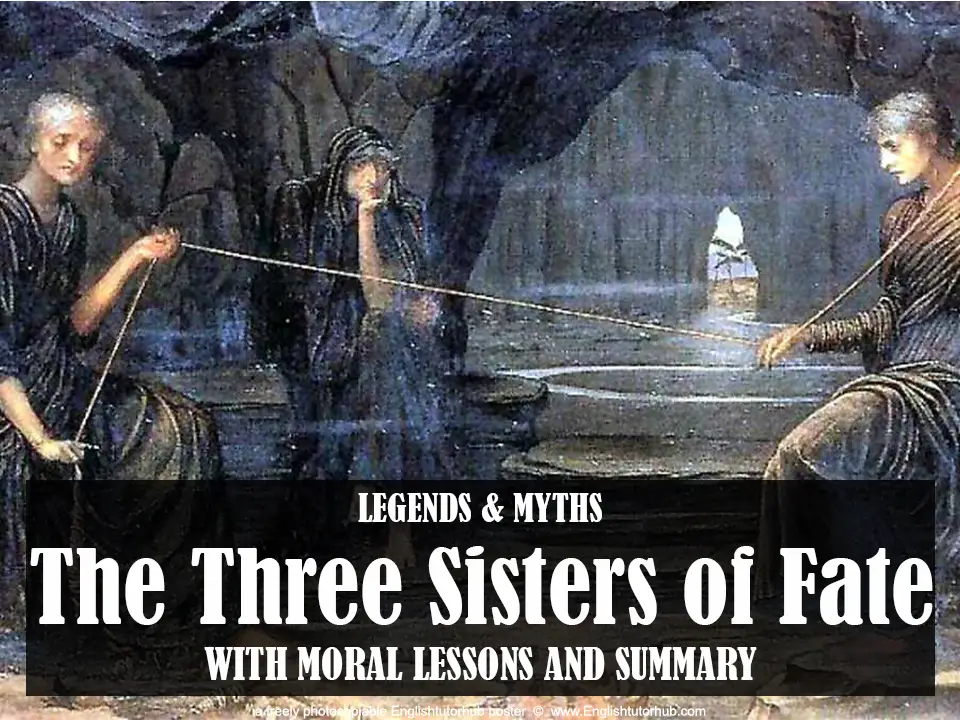THE THREE SISTERS OF FATE – The fates hold one’s destiny. The story of The Three Sisters of Fate, with moral lesson and summary, shows us how one’s life starts and ends at the hands of Greek mythologies Moirai.
According to ancient Greeks, each human’s actions are predestined, for the Fates or Moirai control the thread of life. Let us get to know them with the story below and know how they are related to the gods and goddesses.

The Three Sisters Of Faith
Long gone at the time of the gods and goddesses in Greek mythology, there are the Fates or the Moirai, the goddesses of Fate. They are Clotho, Lachesis, and Atropos.
The Fates are the divine beings who control humankind’s birth, life, and death. Humans have free will, but their action is predestined by the Fates, who know their actions and choices.
No one has the power to influence them. Not even the gods could challenge their decisions. They wove together the destiny of humanity and the gods.
They are called the Moirai, translated as allotted portion or share. The Fates or Moirai deal with the allotted portion of life, for they each have different roles in handling one’s Fate.
Clotho, the youngest, spins the thread of life. She is the beginning, and the very creation for her thread is spun when a person is born. Clotho begins spinning the thread while the person is still in the womb.
The second of the Moirai is Lachesis, which measures the thread of a person’s life. She is called the allotter, for she allows a mortal life for each soul. She determines how long one can live and how many trials one faces.
Atropos is the last sister among the Fates. She is the shearer of the thread of life and chooses how each person will die. Atropos’s name translates as the un-turnable or she who cannot be turned.
Being the chief god and the father of these girls, Zeus had the Fates kill humankind because he lusted for revenge. He once commanded the Fates not to cut some and asked Clotho to re-spin the cut piece.
Atropos’s shears were always sharp and made perfect cuts with no loose ends when she severed the thread. The sisters of Fate were also known for fighting the giants and titans in the war and killing many of them.
Story Analysis Of The Three Sisters Of Fate
In Greek mythology, every yarn strand that the Fates represents all humankind’s and gods’ lives. They can create life and end it at their own pace.
The Moirai or Fates have different roles in weaving the fate of humankind. Each has the free will to do whatever they like in life, but they know each person’s ultimate actions and choices.
Whether mortal or not, the Greek people have to address the Fates. They can tell things and decide whether one would die or continue living.
The Three Sisters Of Fate Moral Lesson
- You’re going to die at the right moment. In the meantime, live life freely with honor.
- In the story, the Fates create life, decide how long one can live, and cuts the thread for death. In the real world, we will all die, but if that moment comes, let us make sure we leave good memories of ourselves so that people can remember our goodness.
The Three Sisters Of Fate Summary
The story tells us that during the time of the gods in Greek mythology, there were the Moirai, or the three goddesses of Fate. They are Clotho, Lachesis, and Atropos.
They are the divine beings that control humankind’s birth, life, and death. No one has the power to influence them.
Clotho being the youngest spins the thread of life, for she is the beginning. Lachesis is the second, which is the allotter. And Atropos, the last sister, is the shearer of the thread of life and chooses how each person will die.
Click and read these articles to learn more
- Why Rabbit Has A Short Tail Story With Moral Lesson/Summary
- How Elephant Got Its Trunk Story With Moral Lesson/Summary
- Pele Hawaiian Goddess Story With Moral Lesson And Summary
- The Story Of Hephaestus With Moral Lesson And Summary
- Clash Of The Titans Story With Moral Lesson And Summary
Learn with englishtutorhub.com

